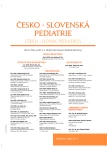Noonan syndrome and other RASopathies: Aetiology, diagnostic procedures and therapy
Authors:
J. Lebl; S. Koloušková; L. Toni; A. Kodýtková; S. A. Amaratunga; L. Plachý; Š. Průhová
Authors‘ workplace:
Pediatrická klinika 2. lékařské fakulty UK a Fakultní nemocnice Motol, Praha
Published in:
Čes-slov Pediat 2020; 75 (4): 219-226.
Category:
Overview
Noonan syndrome and related conditions are classified as RASopathies due to their shared molecular pathogenesis. They represent frequent developmental syndromes with prevalence ranging from 1 : 1000 to 1 : 2500 live-born children, and follow an autosomal dominant mode of inheritance, with up to 60% of cases occurring sporadically due to de novo gene mutations. RASopathies are clinically characterized by the typical facial phenotype, delayed growth, and cardiac disease – predominantly pulmonary stenosis (50–60%) and/or hypertrophic cardiomyopathy (20%). Typical clinical presentations include failure to thrive with developmental delay and macrocephaly in infants, and growth delay with typical facial appearance and heart disease in older children. Adults with Noonan syndrome reach a mean height of only 162.5 cm (males) or 152.7 cm (females), due to the multifactorial growth disorder. Growth hormone administration leads to a final height increase from -2.5 SD to -1.4 SD (mean) and thereby extenuates the height handicap. Since 2020, growth hormone has been approved for treatment in Noonan syndrome in the E.U. by national medicine agencies. Individual treatment decisions are the responsibility of paediatric endocrinologists.
Keywords:
RASopathies – Noonan syndrome – hypertrophic cardiomyopathy – Growth hormone – pulmonary stenosis – growth
Sources
1. Noonan JA, Ehmke DA. Associated noncardiac malformations in children with congenital heart disease. J Pediatr 1963; 63 : 468–470.
2. Opitz JM. The Noonan syndrome. Am J Med Genet 1985; 21 : 515–518.
3. Millet BS. The history of Noonan syndrome. Pediatr Endocrinol Rev 2019; 16 (Suppl 2): 424–427.
4. Tartaglia M, Mehler EL, Goldberg R, et al. Mutations in PTPN11, encoding the protein tyrosine phosphatase SHP-2, cause Noonan syndrome. Nat Genet 2001; 29 : 465–468.
5. Breilyn MS, Mehta L. Clinical manifestations of Noonan syndrome and related disorders. Pediatr Endocrinol Rev 2019; 16 (Suppl 2): 428–434.
6. Romano AA, Allanson JE, Dahlgren J, et al. Noonan syndrome: clinical features, diagnosis, and management guidelines. Pediatrics 2010; 126 : 746–759.
7. Roberts AE, Allanson JE, Tartaglia M, et al. Noonan syndrome. Lancet 2013; 381 : 333–342.
8. Gaete X, Rodríguez F, Cassorla F. Growth hormone treatment for patients with Noonan syndrome. Pediatr Endocrinol Rev 2018; 16 (Suppl 1): 100–104.
9. Allanson JE. Noonan syndrome. J Med Genet 1987; 24 : 9–13.
10. Rogol AD, Hayden GF. Etiologies and early diagnosis of short stature and growth failure in children and adolescents. J Pediatr 2014; 164 (Suppl 5): S1–S14.
11. Ranke MB, Heidemann P, Knupfer C, et al. Noonan syndrome: growth and clinical manifestations in 144 cases. Eur J Paediatr 1988; 148 : 220–227.
12. Van der Burgt I. Noonan syndrome. Orphanet J Rare Dis 2007; 2 : 4.
13. Allen MJ, Sharma S. https://www.ncbi.nlm.nih.gov/books/NBK532269/.
14. Tidyman WE, Rauen KA. The RASopathies: developmental syndromes of Ras/MAPK pathway dysregulation. Curr Opin Genet Dev 2009; 19 : 230–236.
15. Liao J, Mehta L. Molecular genetics of Noonan syndrome and RASopathies. Ped Endocrinol Rev 2019; 16 (Suppl 2): 435–446.
16. Noordam C, van der Burgt I, Sweep CG, et al. Growth hormone (GH) secretion in children with Noonan syndrome: frequently abnormal without consequences for growth or response to GH treatment. Clin Endocrinol (Oxf) 2001; 54 : 53–59.
17. Binder G, Neuer K, Ranke MB, et al. PTPN11 mutations are associated with mild growth hormone resistance in individuals with Noonan syndrome. J Clin Endocrinol Metab 2005; 90 : 5377–5381.
18. Choi JH, Lee BH, Jung CW, et al. Response to growth hormone therapy in children with Noonan syndrome: correlation with or without PTPN11 gene mutation. Horm Res Paediatr 2012; 77 : 388–393.
19. Ferreira LV, Souza SA, Arnhold IJ, et al. PTPN11 (protein tyrosine phosphatase, nonreceptor type 11) mutations and response to growth hormone therapy in children with Noonan syndrome. J Clin Endocrinol Metab 2005; 90 : 5156–5160.
20. Binder G. Response to growth hormone in short children with Noonan syndrome: correlation to genotype. Horm Res 2009;72 (Suppl 2): 52–56.
21. Osio D, Dahlgren J, Wikland KA, et al. Improved final height with long-term growth hormone treatment in Noonan syndrome. Acta Paediatr 2005; 94 : 1232–1237.
22. Dahlgren J. GH therapy in Noonan syndrome: Review of final height data. Horm Res 2009; 72 (Suppl 2): 46–48.
23. Giacomozzi C, Deodati A, Shaikh MG, et al. The impact of growth hormone therapy on adult height in Noonan syndrome: a systematic review. Horm Res Paediatr 2015; 83 : 167–176.
24. Noonan JA, Kappelgaard AM. The efficacy and safety of growth hormone therapy in children with Noonan syndrome: a review of the evidence. Horm Res Paediatr 2015; 83 : 157–166.
25. Lee PA, Ross JL, Pedersen BT, et al. Noonan syndrome and Turner syndrome patients respond similarly to 4 years‘ growth-hormone therapy: longitudinal analysis of growth-hormone-naïve patients enrolled in the NordiNet® International Outcome Study and the ANSWER Program. Int J Pediatr Endocrinol 2015; 2015 (1): 17.
Labels
Neonatology Paediatrics General practitioner for children and adolescentsArticle was published in
Czech-Slovak Pediatrics

2020 Issue 4
Most read in this issue
- Noonan syndrome and other RASopathies: Aetiology, diagnostic procedures and therapy
- Etiology and diagnostic approach of growth failure in children born small for gestational age (SGA) with persistent short stature in childhood (SGA-SS)
- Noonan syndrome from a paediatric cardiologistˇs perspective
- Prenatal phenotype of RASopathies
